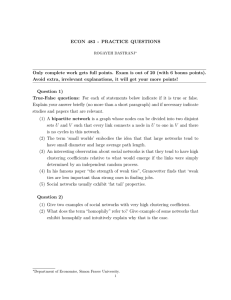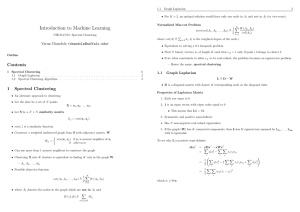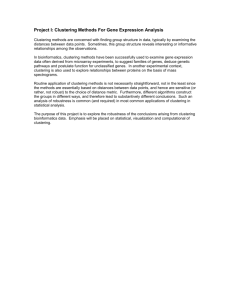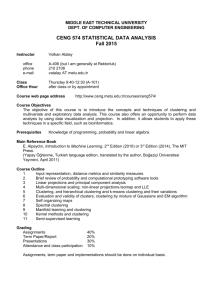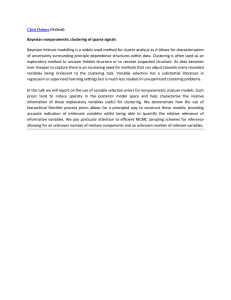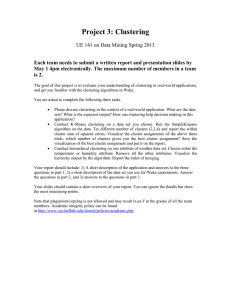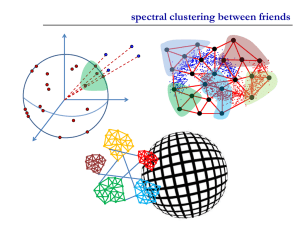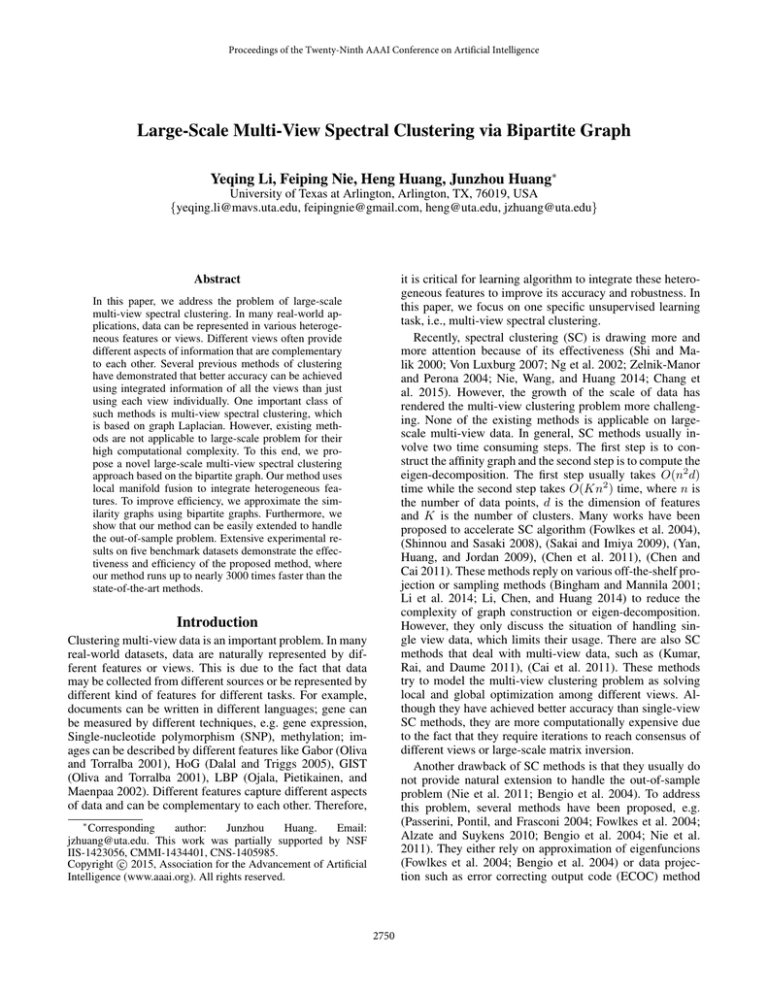
Proceedings of the Twenty-Ninth AAAI Conference on Artificial Intelligence
Large-Scale Multi-View Spectral Clustering via Bipartite Graph
Yeqing Li, Feiping Nie, Heng Huang, Junzhou Huang∗
University of Texas at Arlington, Arlington, TX, 76019, USA
{yeqing.li@mavs.uta.edu, feipingnie@gmail.com, heng@uta.edu, jzhuang@uta.edu}
Abstract
it is critical for learning algorithm to integrate these heterogeneous features to improve its accuracy and robustness. In
this paper, we focus on one specific unsupervised learning
task, i.e., multi-view spectral clustering.
Recently, spectral clustering (SC) is drawing more and
more attention because of its effectiveness (Shi and Malik 2000; Von Luxburg 2007; Ng et al. 2002; Zelnik-Manor
and Perona 2004; Nie, Wang, and Huang 2014; Chang et
al. 2015). However, the growth of the scale of data has
rendered the multi-view clustering problem more challenging. None of the existing methods is applicable on largescale multi-view data. In general, SC methods usually involve two time consuming steps. The first step is to construct the affinity graph and the second step is to compute the
eigen-decomposition. The first step usually takes O(n2 d)
time while the second step takes O(Kn2 ) time, where n is
the number of data points, d is the dimension of features
and K is the number of clusters. Many works have been
proposed to accelerate SC algorithm (Fowlkes et al. 2004),
(Shinnou and Sasaki 2008), (Sakai and Imiya 2009), (Yan,
Huang, and Jordan 2009), (Chen et al. 2011), (Chen and
Cai 2011). These methods reply on various off-the-shelf projection or sampling methods (Bingham and Mannila 2001;
Li et al. 2014; Li, Chen, and Huang 2014) to reduce the
complexity of graph construction or eigen-decomposition.
However, they only discuss the situation of handling single view data, which limits their usage. There are also SC
methods that deal with multi-view data, such as (Kumar,
Rai, and Daume 2011), (Cai et al. 2011). These methods
try to model the multi-view clustering problem as solving
local and global optimization among different views. Although they have achieved better accuracy than single-view
SC methods, they are more computationally expensive due
to the fact that they require iterations to reach consensus of
different views or large-scale matrix inversion.
Another drawback of SC methods is that they usually do
not provide natural extension to handle the out-of-sample
problem (Nie et al. 2011; Bengio et al. 2004). To address
this problem, several methods have been proposed, e.g.
(Passerini, Pontil, and Frasconi 2004; Fowlkes et al. 2004;
Alzate and Suykens 2010; Bengio et al. 2004; Nie et al.
2011). They either rely on approximation of eigenfuncions
(Fowlkes et al. 2004; Bengio et al. 2004) or data projection such as error correcting output code (ECOC) method
In this paper, we address the problem of large-scale
multi-view spectral clustering. In many real-world applications, data can be represented in various heterogeneous features or views. Different views often provide
different aspects of information that are complementary
to each other. Several previous methods of clustering
have demonstrated that better accuracy can be achieved
using integrated information of all the views than just
using each view individually. One important class of
such methods is multi-view spectral clustering, which
is based on graph Laplacian. However, existing methods are not applicable to large-scale problem for their
high computational complexity. To this end, we propose a novel large-scale multi-view spectral clustering
approach based on the bipartite graph. Our method uses
local manifold fusion to integrate heterogeneous features. To improve efficiency, we approximate the similarity graphs using bipartite graphs. Furthermore, we
show that our method can be easily extended to handle
the out-of-sample problem. Extensive experimental results on five benchmark datasets demonstrate the effectiveness and efficiency of the proposed method, where
our method runs up to nearly 3000 times faster than the
state-of-the-art methods.
Introduction
Clustering multi-view data is an important problem. In many
real-world datasets, data are naturally represented by different features or views. This is due to the fact that data
may be collected from different sources or be represented by
different kind of features for different tasks. For example,
documents can be written in different languages; gene can
be measured by different techniques, e.g. gene expression,
Single-nucleotide polymorphism (SNP), methylation; images can be described by different features like Gabor (Oliva
and Torralba 2001), HoG (Dalal and Triggs 2005), GIST
(Oliva and Torralba 2001), LBP (Ojala, Pietikainen, and
Maenpaa 2002). Different features capture different aspects
of data and can be complementary to each other. Therefore,
∗
Corresponding
author:
Junzhou
Huang.
Email:
jzhuang@uta.edu. This work was partially supported by NSF
IIS-1423056, CMMI-1434401, CNS-1405985.
c 2015, Association for the Advancement of Artificial
Copyright Intelligence (www.aaai.org). All rights reserved.
2750
(Dietterich and Bakiri 1995; Passerini, Pontil, and Frasconi
2004) or regression model (Nie et al. 2011). None of them
address the out-of-sample problem in setting involved heterogeneous features.
In this paper, we proposed a multi-view spectral clustering
method that is able to deal with large-scale data. Our method
is inspired by the large-scale semi-supervised learning algorithm proposed in (Liu, He, and Chang 2010). First, we
generate consensus m salient points for all views. Then we
construct bipartite graph between raw data points and these
salient points. These generated points play an important role
in capturing the manifold of the original views. Then, the
graph of all the views are combined together using a local
manifold fusion method. Finally, we run spectral clustering
on the resulting fused graph. There are several benefits of
our method: First, manifold fusion preserves the manifold
structure of all the views; Second, the construction of the
bipartite graph is very efficient; Third, by exploring the special structure of the bipartite graph, spectral analysis on it is
also very efficient; Fourth, our method also output cluster
indicator of the salient points, which enables us to handle
the out-of-sample problem efficiently. Additionally, we have
conducted extensive experiments on five ‘ benchmark data
sets, which demonstrate the effectiveness and efficiency of
our proposed method comparing to the state-of-the-art methods.
The remainder of this paper is organized as follows: we
first introduce basic notations and concepts of spectral clustering in Section 2. In Section 3, details of our proposed
large-scale multi-view spectral clustering method is presented. All the experimental results are shown in Section 4.
Finally, we conclude our work in Section 5.
defined as:
L = I − D−1/2 W D−1/2
(2)
The objective function of the normalized spectral clustering
(Ng et al. 2002) is defined as:
min Tr (GT LG),
GT G=I
(3)
where G ∈ Rn×K is the class indicator matrix of all data.
The solution of G in Eq. (3) is the K smallest eigen vectors
of L.
Multi-view Spectral Clustering Revisit
For multi-view data, let V be the number of views and
X (1) , . . . , X (V ) be the data matrix of each view, where
(v)
X (v) ∈ Rn×d for v ∈ 1 . . . , V and d(v) is the feature
dimension of the v-th view. Let L(1) , . . . , L(V ) ∈ Rn×n
denote the normalized Laplacian matrices of each view, respectively. Two important questions that are needed to be
answered by multi-view approaches are how to reach consensus of the results and how to express the relationship
of all the views. There are several forms for the multiview spectral clustering (Kumar, Rai, and Daume 2011;
Cai et al. 2011). We use the following form:
min
GT G=I,a(v)
J1 (G, a(v) ) =
V
X
(a(v) )r Tr(GT L(v) G),
v=1
s.t.
V
X
a(v) = 1, a(v) ≥ 0, (4)
v=1
(v)
where a is the non-negative normalized weight factor for
the v-th view and r is a scalar to control the distribution of
different weights among different views. Here, we try to find
a consensus result G among all the views. This unique consensus eliminates the need for computing the local results
for each view and the computation cost of communicating
back and forth between local results and the global result
e.g. (Kumar, Rai, and Daume 2011). To further explain the
inter-view relation, we rewrite Eq. (4) as:
Background and Notations
In this section, we will briefly introduce the notations and the
spectral clustering framework. Let X = [x1 , . . . , xn ]T ∈
Rn×d denote the data matrix, where n is the number of
data points and d is dimension of features. Each data point
xi ∈ Rd belongs to one of K classes C = {c1 , . . . , cK }.
Given the whole dataset X, each data point is represented as
a vertex on the affinity graph and each edge represents the
affinity relation of one pair of vertexes. In practice, the k-NN
graph are usually used. Specifically, xi and xj are connected
if at least one of them is among the k nearest neighbours of
the other in the given measured (usually Euclidean distance).
The weight of the edge between xi and xj is defined as:
(
kx −x k
exp − i2σ2 j , if xi and xj are connected
wij =
0,
otherwise
(1)
min
GT G=I,a(v)
J2 (G, a(v) ) = Tr(GT LG),
s.t.
V
X
a(v) = 1, a(v) ≥ 0,
(5)
v=1
PV
where L = v=1 (a(v) )r L(v) . Here, L can be regarded as
local manifold fusion of all the views.
Equation (5) can be solve by iterative optimization techniques. However, to construct the graphs for all the views
and to solve the equation is time consuming.
The computaP
tional complexity is about O(T Kn2 + v=1 V nd2v ), where
T is the number of iterations.
where σ is the bandwidth parameter. Note that we use Gaussian Kernel for example, this method is also applicable to
other types of kernel. Thus, W = {wij } ∈ Rn×n , ∀i, j ∈
1, . . . , n is the adjacent matrix of the graph and it is a symmetric undirected graph. Let D ∈ Rn×n be P
the degree man
trix whose i-th diagonal element is dii =
j=1 wij . Let
L denote the normalized graph Laplacian matrix, then it is
Methodology
In this section, we present an efficient approximation algorithm that can be applied to large-scale graph construction.
Then, an efficient clustering algorithm is proposed for largescale multi-view spectral clustering. Finally, we extended
our method to handle the out-of-sample problem.
2751
With all the a(v) are initialized to be equal, i.e. a(v) = 1/V
for v ∈ 1 . . . V , we solve Eq. (5) in iterations of two following steps.
First, we fix a(v) and then solve G, where the objective
function become:
Large-Scale Graph Construction
In order to reduce the computational cost of multi-view
spectral clustering, we introduce a fast approximation algorithm. The idea is to use a small set of data points
U = [U1 , . . . , Um ] ∈ Rm×d to capture the manifold structure, where each uk is called a salient point. Then a bipartite graph is constructed between the raw data points and
the salient points. By utilizing the structure of the bipartite
graph, the graph construction and spectral analysis can be
perform very efficient.
The salient points can be chosen by random sampling
from raw data points or using lightweight clustering methods such as k-means. We find that the salient points generated by k-means have stronger representation power compared to sampling ones, where fewer points are needed
for the same level of performance. However, in multi-view
data, different views will generate different salient points if
we run k-means independently on each view, which makes
manifold fusion impossible. Therefore, we generate salient
points on concatenated all the features and then separate resulting points into different views. This process can generate
uniform salient points for different views, which will simplified the process of clustering.
With the generated points, the k-NN graph is constructed
between the raw data and the salient points. We further constrain that connections are only allowed between raw data
point and salient point. This constraint results in a bipartite
graph between raw data X and salient points U . And the
weight of each edge is defined as
Zij = P
K(xi , uj )
, ∀j ∈ Φi ,
k∈Φi K(xi , uk )
min J2 (G) = Tr(GT LG),
(7)
GT G=I
which is equivalent to original spectral clustering. The solution of G is obtained by compute K smallest eigenvectors of
L.
Second, we fix G and then solve a(v) . Let h(v) =
Tr(GT L(v) G), then the Eq. (4) can be rewritten as:
min
a(v)
V
X
(a(v) )r h(v) , s.t.
v=1
V
X
a(v) = 1, a(v) ≥ 0,
(8)
v=1
Thus, using method of Lagrange multiplier, Eq. (8) becomes:
V
V
X
X
(v) r (v)
min
(a ) h − β(
a(v) − 1),
(9)
a(v)
v=1
v=1
where β is the Lagrange multiplier. With simple algebraic
manipulations, we get
1
r(h(v) 1−r
(v)
(10)
a =P
1 .
V
(v) 1−r
rh
v=1
The first sub-problem (Eq. (7)) tries to minimize J2 (G) =
Tr(GT LG), which takes O(cn2 ) for general case. Fortunately, we can reduce the complexity by using the following
theorem.
Theorem 1. : Solving J2 (G) = Tr(GT LG) is equivalent
to compute the singular vectors of Z corresponding to K
largest singular values.
(6)
where K() is a given kernel function (e.g. Gaussian Kernel
in Eq. (1)), Φi ⊂ {1 . . . m} denotes the indexes of s nearest
neighbours of xi in U .
(v)
=
" For the v-th#view, the affinity matrix becomes W
(v)
0
Z
∈ R(n+m)×(n+m) . The degree matrix beT
Z (v)
0
#
"
(v)
0
Dr
(v)
comes D
=
∈ R(n+m)×(n+m) , where
(v)
0
Dc
Dr is a diagonal matrix of whose diagonal elements are row
sums of Z and Dc is a diagonal matrix of whose diagonal elements are column sums of Z. Since Z is by definition row
normalized, we have Dr = In , where In is the n by n identity matrix. The construction of the graph is extremely efficient since now we only need to consider O(mn) distances.
However, directly computing eigenvectors of L in Eq. (4) is
still time consuming. Therefore, we need to transform the
problem to utilize the structure of bipartite graph.
Proof. Let S (v) = (D(v) )−1/2 W (v) (D(v) )−1/2 . The objective function J2 (G) can be rewritten as
J2 (G) = Tr(GT LG)
V
X
= Tr(G
(a(v) )r L(v) G)
T
v=1
= Tr(G
!
V
X
(v) r
(v)
(a ) (I − S ) G)
T
v=1
= Tr(
V
X
(a(v) )r GT G
v=1
− GT
V
X
(a(v) )r S (v)
!
G)
v=1
=n
Multi-view Spectral Clustering Algorithm
V
X
(a(v) )r − Tr(GT SG),
(11)
v=1
By utilize the bipartite graph, we can obtain an algorithm
that can optimize the cluster indicator of raw data points
and salient points simultaneously. We name this algorithm
Multi-view Spectral Clustering (MVSC). We first propose
our alternative optimization framework for solving Eq. (5).
PV
(v) r (v)
where S =
) S . Then, minimizing J2 with
v=1 (a
respect to G is equivalent to the following equation
max Tr(GT SG)
GT G=I
2752
(12)
The solution of G is the eigenvectors corresponding to the
K largest eigenvalues. We can use the structure of S to transform the problem of computing the eigenvectors of S to that
of computing the eigenvectors of Z. Let G = [GTX , GTU ]T ,
where GX , GU are rows corresponding to raw data and
salient points respectively. Therefore, the objective function
in Eq. (12) becomes
T !
GX
GX
T
Tr(G SG) = Tr
S
GU
GU
T !
GX
0
Ẑ GX
= Tr
GU
(Ẑ)T 0 GU
= Tr 2GTX ẐGU ,
(13)
PV
(v) r
(v)
Parameter r. Another advantage of our approach is using the parameter r, which controls the fusion weights of all
the views by only one parameter. Some previous methods
just simply assume equal weights (Kumar, Rai, and Daume
2011) or tuning one parameter for each view (Liu et al.
2013). The effect of r ranges from assigning equal weights
to all views when r = ∞ to assigning all the weights to one
best view when r = 1. By tuning r between (1, ∞) we can
reach a balance between all the views.
Algorithm 1 Multi-view Spectral Clustering (MVSC)
(v)
1: Input: Data matrix of all views X (v) ∈ Rn×d
2:
(v)
where Ẑ
=
) Ẑ
and Ẑ
=
v=1 (a
(v) − 1 (v)
(v) − 1
(v) − 1
(v)
(Dr ) 2 Z (Dc ) 2 = Z (Dc ) 2 . Thus, solving
Eq. (12) is equivalent to computing the left and right
singular vectors corresponding to the K largest singular
values of Ẑ
svd(Ẑ) = GX ΣGTU ,
for
v ∈ 1 . . . V , Number of classes K, Number of salient
points m, parameter r.
Output: Cluster labels Y of each data points, all salient
points U and cluster labels of all salient points.
Generate m salient points using k-means on concatenate
features;
Compute affinity matrix Z (v) of each view.
Compute Laplacian L(v) of each view;
Initialize a(v) = 1/K;
repeat
Compute G by using Eq. (14);
Update a(v) by using Eq. (8);
until Converges.
Treat each row of G as new representation of each data
point and compute the clustering labels Y by using kmeans algorithm.
3:
4:
5:
6:
7:
8:
9:
10:
11:
(14)
where svd() is the Singular Value Decomposition (SVD) operator, Σ = diag(σ1 , . . . , σK ) and σ1 ≥ σ2 , . . . , σK ≥ 0
are the singular values of Ẑ.
With Theorem 1, we can solve the whole problem very
efficiently. The whole algorithm is summarized in Alg. 1.
Computational analysis. The proposed Multi-view
Spectral Clustering (MVSC) consists of three stages: 1) generating salient points using k-means, 2) constructing graph
Z and 3) optimization by iteratively solving the clustering
problem. The first stage takes O(t1 nmd) time, where t1
is the number of iterations for running k-means and d =
PV
(v)
. The second stage takes O(nmd) to construct
v=1 d
the graph Z, while constructing a normal k-NN graph of
n vertexes takes O(n2 d). The third stage takes O(t2 nm2 ),
where t2 is the number of iterations. Note that the optimization stage is much faster than clustering on a normal n by
n graph, which takes O(Kn2 ) time. So the overall time
complexity is approximately O(t1 nmd + t2 nm2 ). Since
m, d n, this is nearly linear to n. The computational cost
is summarized in Table 1.
Out-of-sample Problem
In general, spectral clustering methods only work on the
training data. Most methods do not provide clear extension
to deal with out-of-sample points (a.k.a. test data). In contrast, our method can be easily extended to handle test data.
Recall that when carrying out clustering on training data,
we also get the feature vectors and clustering labels for the
salient points. Therefore, we simple find the k nearest neighbours of test data among salient points and propagate the
labels to the test data. The k-NN algorithm can be done in
O(md) computational cost for each data point. Hence, p test
data points can be clustered in O(pmd) computational cost.
This computational cost is far lower than carried out k-NN
on the training data (O(pnd)).
Experiment
Table 1: Summary of computational complexity.
In this section, we conduct several experiments to evaluate
the performance of the proposed methods on five benchmarks datasets. These datasets are summarized in Table 2.
All our experiments are conducted on a desktop computer
with a 3.4GHz Intel Core i7 CPU and 12GB RAM, MatLab
2012a (64bit).
Stages
1 and 2
3
Total
Normal graph
O(n2 d)
O(Kn2 )
O(n2 d + Kn2 )
Bipartite graph O(t1 nmd) O(t2 nm2 ) O(t1 nmd + t2 nm2 )
Convergence analysis. The original problem Eq. (4) is
not a joint convex problem of a(v) and G. Hence, there is
no guarantee for obtaining a global solution. Since we divide the original problem into two sub-problems and each
of them is convex problem. The proposed method will converge to a local solution. In all our experiments, the process
always converges in less than 10 iterations.
Data Set Description
Handwritten (HW)1 is a dataset of handwritten digits of 0
to 9 from UCI machine learning repository (Frank, Asun1
2753
https://archive.ics.uci.edu/ml/datasets/Multiple+Features
Co-regularized Spectral Clustering (CoregSC): one of
the state-of-the-art multi-view spectral clustering method
proposed in (Kumar, Rai, and Daume 2011).
Multi-Modal Spectral Clustering (MMSC): another recent multi-view clustering method proposed in (Cai et al.
2011).
Multi-view Spectral Clustering (MVSC): this is the proposed method in Alg. (1).
For fair comparison, we download the source code from
the authors’ website and follow their experimental setting
and the parameter tuning steps in their paper. And we
use Gaussian kernel for all the experiments except for the
Reuters dataset, where we use linear kernel. We search the
parameter r in logarithm form (log10 r from 0.1 to 2 with
step size 0.2. We also set m = 400 and construct 8-nearestneighbour graph between raw All the experiments are repeated for 10 times and average results are reported. For
the experimental results, we report three metrics (Manning,
Raghavan, and Schütze 2008): mean purity, mean mutual
information (NMI) and mean running time.
cion, and others 2010). It consists of 2000 data points. We
use all the 6 published features including 76 Fourier coefficients of the character shapes (FOU), 216 profile correlations (FAC), 64 Karhunen-love coefficients (KAR), 240
pixel averages in 2 × 3 windows (Pix), 47 Zernike moment
(ZER) and 6 morphological (MOR) features.
Caltech-101 (Fei-Fei, Fergus, and Perona 2007) image
data set consists of 101 categories of images for object
recognition problem. We follow previous work (Dueck and
Frey 2007) and select the widely used 7 classes, i.e. Face,
Motorbikes, Dolla-Bill, Garfield, Snoopy, Stop-Sign and
Windsor-Chair and get 1474 images, which we called Caltech7 (Cal7). We also select a larger set named Caltech20
(Cal20) which contains totally 2386 images of 20 classes:
Face, Leopards, Motorbikes, Binocular, Brain, Camera,
Car-Side, Dolla-Bill, Ferry, Garfield, Hedgehog, Pagoda,
Rhino, Snoopy, Stapler, Stop-Sign, Water-Lilly, WindsorChair, Wrench and Yin-yang. Five features are extracted
from all the images: i.e. 48 dimension Gabor feature, 40
dimension wavelet moments (WM), 254 dimension CENTRIST feature, 1984 dimension HOG feature, 512 dimension GIST feature, and 928 dimension LBP feature.
Reuters2 consists of documents that are written in five
different languages and their translations. All the documents
are categorized in to 6 classes. We use the subset that are
written in English all their translations in all the other 4 languages (French, German, Spanish and Italian).
NUS-WIDE-Object (NUS) (Chua et al. July 8 10 2009)
is a dataset for object recognition which consists of 30000
images in 31 classes. We use 5 features provided by the website 3 , i.e. 65 dimension color Histogram (CH), 226 dimension color moments (CM), 145 dimension color correlation
(CORR), 74 dimension edge distribution and 129 wavelet
texture.
Animal with attributes (AWA)4 is a data set of animal images. It consists of 50 kinds of animals described in
6 features. We randomly sample 80 images for each class
and get 4000 images in total. All the published features
are used: Color Histogram (CQ, dim 2688), Local SelfSimilarity (LSS, dim 2000), Pyramid HOG (PHOG, dim
252), SIFT (dim 2000), Color SIFT (RGSIFT, dim 2000)
and SURF (dim 2000).
Table 3: Clustering purity comparison on all data sets. “OM”
means “Out-of-memory error” while running the experiment.
Data set
SC(1)
SC(2)
SC(3)
SC(4)
SC(5)
SC(6)
ConcatSC
CoRegSC
MMSC
Proposed
HW
75.12%
75.44%
76.39%
73.47%
75.84%
78.89%
59.33%
82.23%
75.84%
84.41%
Cal7
79.22%
79.85%
79.36%
80.56%
80.48%
79.97%
77.96%
83.71%
84.47%
84.66%
Cal20
68.13%
68.13%
69.09%
67.01%
67.99%
66.90%
60.33%
76.11%
69.04%
74.06%
Reuters
53.10%
54.86%
56.92%
53.82%
56.79%
56.70%
55.23%
39.01%
57.73%
NUS
15.98%
16.13%
15.78%
16.29%
16.44%
26.81%
26.49%
OM
28.21%
Table 4: Clustering NMI comparison on all data sets. “OM”
means “Out-of-memory error” while running the experiment.
Data set
SC(1)
SC(2)
SC(3)
SC(4)
SC(5)
SC(6)
ConcatSC
CoRegSC
MMSC
Proposed
Clutering Evaluation
In this subsection, we first evaluate the capability of the proposed multi-view clustering method on 5 datasets: HW, Caltech7, Caltech20, Reuters and NUS. We compare the proposed methods with three other state-of-art approaches as
stated bellow:
Single view Spectral Clustering (SC): Running spectral
clustering on each single view (Ng et al. 2002).
Feature Concatenation Spectral Clustering (ConSC):
Concatenating features of all the views and run spectral
clustering on the resulted feature (Kumar, Rai, and Daume
2011).
HW
0.7589
0.7549
0.7556
0.7547
0.7576
0.7577
0.5795
0.8358
0.7920
0.8324
Cal7
0.4189
0.4239
0.4217
0.4220
0.4206
0.4190
0.2734
0.5253
0.5638
0.5586
Cal20
0.4842
0.4813
0.4848
0.4816
0.4830
0.4830
0.3590
0.6107
0.5938
0.5698
Reuters
0.3099
0.3033
0.3039
0.3123
0.3078
0.3228
0.3261
0.1335
0.3567
NUS
0.0398
0.0419
0.0403
0.0432
0.0429
0.1421
0.1428
OM
0.1493
Table 3 and Table 4 show clustering purity and NMI respectively, while Table 5 shows the running time of all the
methods. In general, the multi-view methods can achieve
better results than the single view algorithms. Additionally,
our proposed method MVSC constantly outperforms the single view methods and achieves comparable or even better
results than the other multi-view methods. For running time
2
https://archive.ics.uci.edu/ml/datasets.html
http://lms.comp.nus.edu.sg/research/NUS-WIDE.htm
4
http://attributes.kyb.tuebingen.mpg.de/
3
2754
No.
1
2
3
4
5
6
# of data
# of classes
Table 2: Summary of the multi-view datasets used in our experiments.
HW
Caltech7/20
Reuters
NUS
AWA
Pix(240)
Gabor(48)
English(21531)
CH(65)
CQ(2688)
Fou(76)
WM(40)
France(24892)
CM(226)
LSS(2000)
Fac(216) CENTRIST(254) German(34251) CORR(145)
PHOG(252)
ZER(47)
HOG(1984)
Italian(15506)
EDH(74)
SIFT(2000)
KAR(64)
GIST(512)
Spanish(11547)
WT(129)
RGSIFT(2000)
MOR(6)
LBP(928)
SURF(2000)
2000
1474/2386
18758
26315
4000
20
7/20
6
31
50
each testing sample.
Table 5: Running time comparison on all data sets (seconds).
“OM” means “Out-of-memory error” while running the experiment.
Data set
SC(1)
SC(2)
SC(3)
SC(4)
SC(5)
SC(6)
ConcatSC
CoRegSC
MMSC
Proposed
HW
1.74
1.54
1.53
1.53
1.58
1.53
2.20
16.42
6.13
0.84
Cal7
10.94
10.30
10.20
10.16
10.32
10.24
11.00
61.78
27.62
1.21
Cal20
29.18
29.27
29.32
29.15
29.32
29.33
26.19
180.65
80.25
2.26
Reuters
556.98
443.92
422.91
354.68
307.62
556.73
7074.17
14556.13
135.48
Table 6: Results of out-of-sample test om AWA.
NUS
852.07
580.36
478.88
527.62
633.01
2172.90
56327.26
OM
19.34
Method
Purity
NMI
Time (s)
1NN
8.13%
0.1395
972.53
LR
7.22%
0.1124
0.97
SEC
7.79%
0.1252
0.99
Sa1NN
8.37%
0.1490
436.45
SaLR
7.31%
0.1120
0.94
Table 6 shows the testing performance of all the methods.
The first two rows of the table are purity and NMI, respectively, while the third row shows the testing time. We can
observe that the purity of the salient-point-based models are
comparable or even better than the raw-data-based models.
The testing time of Sa1NN is much less than the 1NN model.
This is reasonable since the computational complexity of
1NN algorithm is proportional to the number of training
samples. All these results demonstrate that we can achieve
comparable performance using models trained only on the
salient points.
comparison in Table 5, the proposed method is up to several orders of magnitude faster than the baseline methods.
The gap is even larger in the large datasets. The other benefits of the proposed method is low space complexity. In fact,
nearly all the baseline methods raise out-of-memory exception when number of data points are more than 40,000 while
the proposed method can easily handle more than 100,000
samples at once.
Conclusion
In this paper, we propose a novel large-scale multi-view
spectral clustering method based on bipartite graph, named
MVSC. Given a multi-view data set with n data points,
MVSC select m uniform salient points among all the views
to represent the manifold structures of all the features. For
each view, one sub-bipartite-graph is constructed between
the raw data points and the generated salient points. We use
local manifold fusion to generate a fused bipartite graph to
integrate information of all the sub-graph. By exploring the
structure of the bipartite graph, the clustering process can
be accelerated significantly. The computational complexity
is close to linear to the number of data points. For the clustering results, we not only obtain cluster labels for the training data but also cluster labels for the salient points. The
later information has been used to handle the out-of-sample
problem in low computational cost. Extensive experiments
on five benchmark data sets demonstrate that our proposed
method is up to several orders of magnitude faster than the
state-of-the-art methods, while preserving the comparable or
even better accuracy.
Out-of-sample Problem
In this subsection, we consider the out-of-sample problem.
Experiments are conducted on AWA dataset. Five fold crossvalidation is used and we report the mean purity, the mean
NMI and the mean testing time. At each fold, 1/5 of the
data are used as in-sample clustering like that in the previous subsection and the other 4/5 are used for the out-ofsample test. For the out-of-sample test, the data and the estimated cluster labels of the in-sample clustering are used
as training data for the model. Here we compare two situations: 1) training model with the whole raw in-sample
data; 2) training model with the generated salient points.
Two kinds of models are trained in both situation: Linear
Regression (LR) and Nearest Neighbour (1NN). The corresponding models trained on the salient points are called
Salient 1 Nearest Neighbour (Sa1NN) and Salient Linear Regression (SaLR) respectively. We compare the proposed method with a third baseline method Spectral Embedded Clustering (SEC) (Nie et al. 2011). Since the data have
several views, we train and apply models on each view and
use simple voting scheme to decide the final cluster label for
References
Alzate, C., and Suykens, J. A. 2010. Multiway spectral
clustering with out-of-sample extensions through weighted
2755
Li, Y.; Chen, C.; and Huang, J. 2014. Transformationinvariant collaborative sub-representation. In Proceedings of
the 22nd International Conference on Pattern Recognition.
Liu, J.; Wang, C.; Gao, J.; and Han, J. 2013. Multi-view
clustering via joint nonnegative matrix factorization. In
Proc. of SDM, volume 13, 252–260. SIAM.
Liu, W.; He, J.; and Chang, S.-F. 2010. Large graph construction for scalable semi-supervised learning. In Proceedings of the 27th International Conference on Machine
Learning (ICML-10), 679–686.
Manning, C. D.; Raghavan, P.; and Schütze, H. 2008. Introduction to information retrieval, volume 1. Cambridge
university press Cambridge.
Ng, A. Y.; Jordan, M. I.; Weiss, Y.; et al. 2002. On spectral
clustering: Analysis and an algorithm. Advances in neural
information processing systems 2:849–856.
Nie, F.; Zeng, Z.; Tsang, I. W.; Xu, D.; and Zhang, C. 2011.
Spectral embedded clustering: A framework for in-sample
and out-of-sample spectral clustering. Neural Networks,
IEEE Transactions on 22(11):1796–1808.
Nie, F.; Wang, X.; and Huang, H. 2014. Clustering and projected clustering with adaptive neighbors. In Proceedings of
the 20th ACM SIGKDD international conference on Knowledge discovery and data mining, 977–986. ACM.
Ojala, T.; Pietikainen, M.; and Maenpaa, T. 2002. Multiresolution gray-scale and rotation invariant texture classification
with local binary patterns. Pattern Analysis and Machine
Intelligence, IEEE Transactions on 24(7):971–987.
Oliva, A., and Torralba, A. 2001. Modeling the shape of
the scene: A holistic representation of the spatial envelope.
International journal of computer vision 42(3):145–175.
Passerini, A.; Pontil, M.; and Frasconi, P. 2004. New results
on error correcting output codes of kernel machines. Neural
Networks, IEEE Transactions on 15(1):45–54.
Sakai, T., and Imiya, A. 2009. Fast spectral clustering with
random projection and sampling. In Machine Learning and
Data Mining in Pattern Recognition. Springer. 372–384.
Shi, J., and Malik, J. 2000. Normalized cuts and image
segmentation. Pattern Analysis and Machine Intelligence,
IEEE Transactions on 22(8):888–905.
Shinnou, H., and Sasaki, M. 2008. Spectral clustering for
a large data set by reducing the similarity matrix size. In
LREC.
Von Luxburg, U. 2007. A tutorial on spectral clustering.
Statistics and computing 17(4):395–416.
Yan, D.; Huang, L.; and Jordan, M. I. 2009. Fast approximate spectral clustering. In Proceedings of the 15th ACM
SIGKDD international conference on Knowledge discovery
and data mining, 907–916. ACM.
Zelnik-Manor, L., and Perona, P. 2004. Self-tuning spectral
clustering. In Advances in neural information processing
systems, 1601–1608.
kernel pca. Pattern Analysis and Machine Intelligence, IEEE
Transactions on 32(2):335–347.
Bengio, Y.; Paiement, J.-F.; Vincent, P.; Delalleau, O.;
Le Roux, N.; and Ouimet, M. 2004. Out-of-sample extensions for lle, isomap, mds, eigenmaps, and spectral clustering. Advances in neural information processing systems
16:177–184.
Bingham, E., and Mannila, H. 2001. Random projection
in dimensionality reduction: applications to image and text
data. In Proceedings of the seventh ACM SIGKDD international conference on Knowledge discovery and data mining,
245–250. ACM.
Cai, X.; Nie, F.; Huang, H.; and Kamangar, F. 2011. Heterogeneous image feature integration via multi-modal spectral clustering. In Computer Vision and Pattern Recognition
(CVPR), 2011 IEEE Conference on, 1977–1984. IEEE.
Chang, X.; Nie, F.; Ma, Z.; and Yang, Y. 2015. A convex
formulation for spectral shrunk clustering. In AAAI.
Chen, X., and Cai, D. 2011. Large scale spectral clustering
with landmark-based representation. In AAAI.
Chen, W.-Y.; Song, Y.; Bai, H.; Lin, C.-J.; and Chang, E. Y.
2011. Parallel spectral clustering in distributed systems. Pattern Analysis and Machine Intelligence, IEEE Transactions
on 33(3):568–586.
Chua, T.-S.; Tang, J.; Hong, R.; Li, H.; Luo, Z.; and Zheng,
Y.-T. July 8-10, 2009. Nus-wide: A real-world web image
database from national university of singapore. In Proc. of
ACM Conf. on Image and Video Retrieval (CIVR’09).
Dalal, N., and Triggs, B. 2005. Histograms of oriented gradients for human detection. In Computer Vision and Pattern Recognition, 2005. CVPR 2005. IEEE Computer Society Conference on, volume 1, 886–893. IEEE.
Dietterich, T. G., and Bakiri, G. 1995. Solving multiclass
learning problems via error-correcting output codes. arXiv
preprint cs/9501101.
Dueck, D., and Frey, B. J. 2007. Non-metric affinity propagation for unsupervised image categorization. In Computer
Vision, 2007. ICCV 2007. IEEE 11th International Conference on, 1–8. IEEE.
Fei-Fei, L.; Fergus, R.; and Perona, P. 2007. Learning generative visual models from few training examples: An incremental bayesian approach tested on 101 object categories.
Computer Vision and Image Understanding 106(1):59–70.
Fowlkes, C.; Belongie, S.; Chung, F.; and Malik, J. 2004.
Spectral grouping using the nystrom method. Pattern
Analysis and Machine Intelligence, IEEE Transactions on
26(2):214–225.
Frank, A.; Asuncion, A.; et al. 2010. Uci machine learning
repository.
Kumar, A.; Rai, P.; and Daume, H. 2011. Co-regularized
multi-view spectral clustering. In Advances in Neural Information Processing Systems, 1413–1421.
Li, Y.; Chen, C.; Liu, W.; and Huang, J. 2014. Subselective
quantization for large-scale image search. In AAAI.
2756

